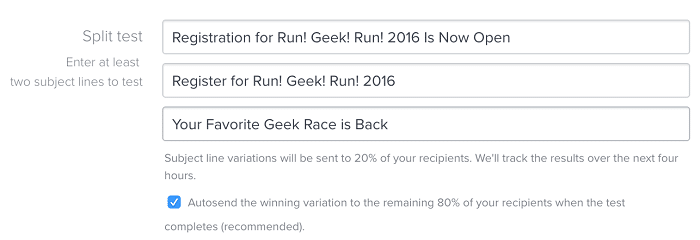Are your digital marketing campaigns falling short of your expectations? Sometimes, all it takes is a little tweaking of your existing campaigns to give them that extra push.
In this blog post, I’ll list the top 6 mistakes that I often see people make when managing digital marketing campaigns in each of the five major categories. Then, I’ll tell you how to avoid them.

Mistake# 1. Not engaging with people on social media
If your company is on social media, that’s a great start! However, you’re making a big mistake and missing some prime opportunities if you’re just scheduling posts in an auto-scheduler like Hootsuite.
Setting up your social media accounts and just posting to them isn’t quite enough—social media has to be monitored consistently. Someone at your company should be responsible for regularly responding to comments and questions on social media.
Consumers have increasingly been turning to social media to voice their customer service concerns, so make sure you have a member of your customer service team ready to address any issues.
And let’s face it, there will likely be people who dislike your company or post negative comments for no reason.
Don’t ignore them! Respond to their comments, treat them with respect, and if possible, direct them to a private source of communication like email to address their issue.
- Good read on social Media: 3 Ways to Better Engage Millennials on Social Media
Mistake# 2. Not doing A/B testing with your emails
So you’re sending out emails to your database, but do you know what causes your audience to open them?
What causes them to click through your emails, or even make a purchase?
This is a major digital marketing mistakes that marketers often do is not using A/B testing with their email template.
Whenever possible, you should always be testing different variables in your promotional emails.
You can do A/B testing in a variety of ways. Experiment with different subject lines (I recommend 2-3) to see which gets the highest click-through rate.
Depending on which email marketing provider you use, this may be a built-in feature.
In Emma, for example, you have the option of entering 3 subject lines.
These three subject lines get sent equally to 20% of your audience and whichever subject line produces the biggest open rate is used for the remaining 80% of your audience.

Within the email itself, try to play around with different layouts. Maybe your audience prefers emails with one main message; maybe they prefer a newsletter type of email with multiple news articles that they can browse through. Send a few different layouts to the same sample audience and then take a look at the email analytics and see which produces a higher open, click-through, and conversion rate.
You can also play around with sending emails at different times to see which produces the highest open rate.
Maybe your audience receives dozens of emails in the morning, but few at night; you may want to consider sending your emails in the evening to give them a better chance of standing out.
- Good read on email outreach mistake: Top 5 Email Outreach Mistakes
- Good read on email marketing: Email Marketing is Dead…Not!
- Good read on A/B test: A/B Testing Your Email Marketing
Mistake# 3. Not doing keyword research
If you have a content/editorial calendar and are regularly producing new content, congratulations—you’re headed in the right direction!
But was your editorial calendar put together strategically, or did you just have a big team brainstorming session about content you should put out?
If it’s the latter, don’t fret—there are easy ways to optimize your content to make sure it’s being found by search engines and ultimately, users.
As you are putting together or tweaking your editorial calendar, try to do keyword research to see what people are searching for.
The bottom line is: you may be producing the most valuable content on the web, but if no one is searching it, no one cares.
I’ll give you an example. Here are three keywords for possible blog content (using the Keyword Planner from Google AdWords).
Let’s say you’re writing a blog post on how to protect your skin from the sun.
Think about what people would search if they are looking for information on this topic.
Then try those keywords in a keyword research tool.
In this example, we would want to optimize the post for “how to prevent sunburn” because it has the lowest competition but the highest average monthly searches.

You want to avoid keywords that have low average monthly searches and high competition.
- Good read on keyword research: Ultimate List of 60+ Keyword Research Tools
Mistake# 4. Not tweaking your campaign on Google AdWords
For Google AdWords, there are a few ways I always tweak a campaign.
First, let the campaign run for about two to three weeks untouched so that you can start to gather some data.
Then, take a look at the keywords people have been searching that have pulled up your ad.
Maybe there’s a particular keyword that’s generated a high click through rate and you should increase your bid on that keyword.
Or maybe your ad is getting clicked on when people are searching for “free” services and you don’t offer those.
You can add “free” as a negative keyword so that your ad does not display when someone includes the word “free” in their search query (saving you money!).
Make sure to also take a look at different keyword match types to include or exclude different queries for which you want your ad to show up.
I also always look at the ads and keywords themselves and see which ones are not getting many clicks.
I might pause those to focus my budget on ads and keywords that are likely to perform well or adjust them based on the analytics.
Finally, take a look at when people are clicking and converting.
Maybe it would make more sense for you to run your ads on the weekends only, or at nighttime.
All of these stats are available in the Google AdWords dashboard.
Mistake# 5. Not Tweaking social media ads
Social media ads can be tweaked in a similar way. Take a look at when people have interacted with your ad—it might make more sense for your budget to run the ads during the business day or in the evening closer to bedtime.
With most social media channels, you can create some version of lookalike audiences.
When you have a group of people that have interacted with your ad, whether it be clicking, commenting, or making a purchase, you can create a new custom audience that mimics those people that have already converted.
That way, you can target even more people who are likely to convert.
- Good read on online advertisement: How To Advertise Online: 10 Helpful Tips
Mistake# 6. Not promoting your social media posts
Organic reach on social media is getting lower and lower (while maybe not ethical, this isn’t surprising; social media networks want you to spend your money with them to give your posts more visibility).
Specifically, on Facebook, it’s getting a lot harder for businesses to get their posts to show up on their fans’ timelines, so really, the only option is to play the game and boost some of your posts.
This is especially important if you’ve just started a Facebook page and don’t have a huge following yet.
It might be a good idea to invest $50-$100 to promote your page a little bit to people who might be interested in your content.
If you’re a local restaurant, target foodies within a 20-mile radius of your business. If you’re a B2B service provider, you may be better off advertising on LinkedIn where you can target professionals who are likely to be the ones making the decision on your service.
- Good read on promoting on social media: How to Use Social Media to Promote Your Business
Mistake# 7. Not tracking your efforts
Even if you start to implement numbers #1 to #5 above, you still have to make sure you track your efforts so that you know which campaigns are bringing your business the most success.
Make sure your website has Google Analytics installed (this should go without saying!) and that you’re using custom URLs whenever you run ads.
For example, if you’re running an ad campaign on Twitter and LinkedIn and you’re sending people to a specific landing page, use the Google URL builder and create two custom URLs, one for Twitter and one for LinkedIn, so that you can track how many people have gotten to your landing page from each ad type.
I hope you found this post useful. Please feel free to share other tips that you think are often forgotten in the comments below.
Emilia Totzeva is Digital Strategist for digital marketing and consulting services firm, Ironistic.com.
